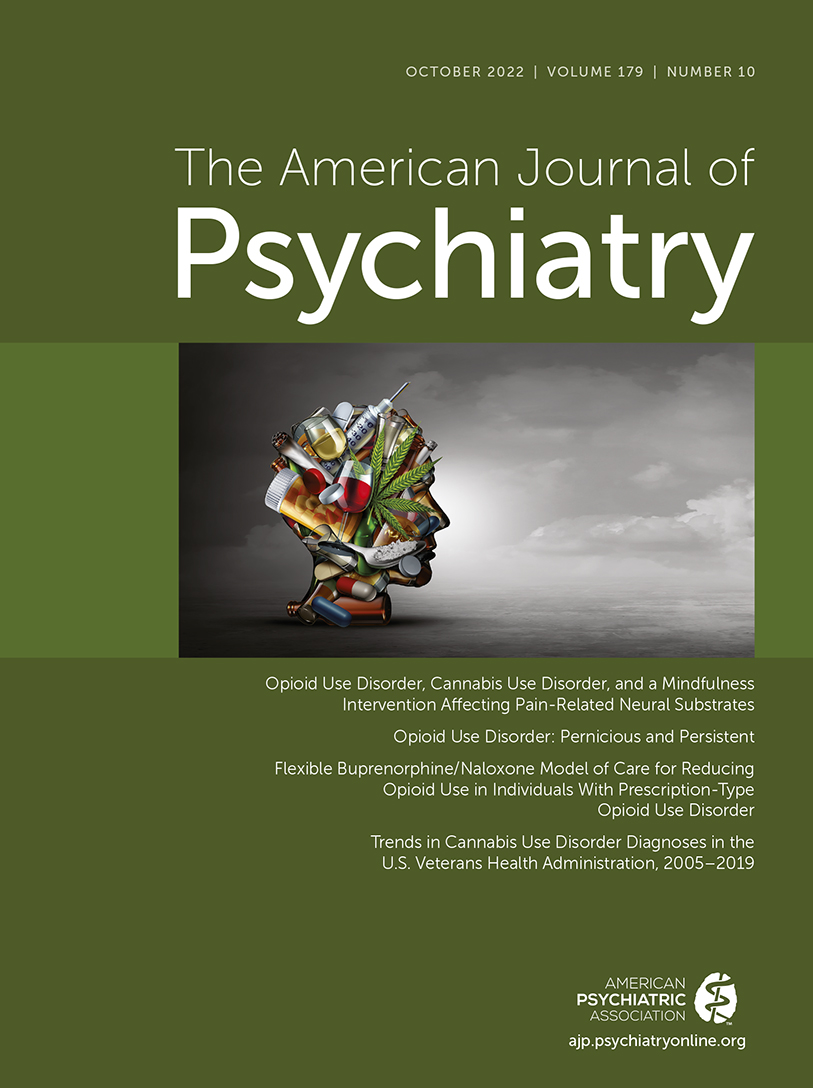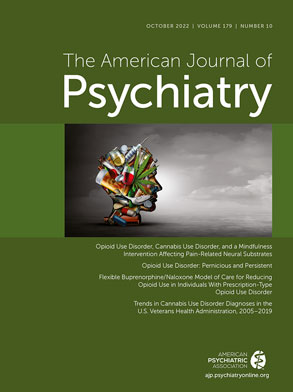Hasin et al. describe a timely and important study in this issue (
1), one that was mandated as part of the U.S. Food and Drug Administration (FDA) postmarketing studies of extended-release and long-acting opioids. Its purpose is to compare and validate three different versions of DSM-5 opioid use disorder (OUD) criteria using the structured Psychiatric Research Interview for Substance and Mental Disorders, DSM-5 opioid version (PRISM-5-OP): 1) completely unadjusted, where all DSM-5 criteria are considered positive if they occurred, including tolerance and withdrawal, regardless of whether opioids were used only as prescribed or not; 2) DSM-5, where withdrawal and tolerance are not considered positive if patients used prescribed opioids only as prescribed; and 3) pain-adjusted, where behavioral/subjective criteria for prescription opioid use disorder (POUD) are not considered positive if pain relief/therapeutic intent was the only motive for the behavior described by the criterion. The study thus compares a standard set of OUD criteria to a set that makes room for long-term opioid therapy (opioid-adjusted) and to a set that makes room for opioid therapy for chronic pain (pain-adjusted). The study sample was collected from both pain and substance abuse clinics. About half of the PRISM-5-OP interviews were administered by telephone and about half in person, with careful attention to test-retest reliability. The investigators derived prevalence rates for the three different OUD criteria. They also validated these criteria by analyzing their relationship with 10 behavioral OUD validators: eight convergent (substance treatment, family history of drug use disorders, other DSM-5 substance use disorders, antisocial personality disorder, internalizing disorder [major depressive episode, generalized anxiety disorder, posttraumatic stress disorder], tampering with medications, impulsivity, sensation seeking) and two divergent (worst pain past week, prescription for legitimate reason). This analysis sought to determine whether the opioid-adjusted and pain-adjusted criteria selected patients more like those seen in substance abuse clinics or more like those seen in pain clinics.
The investigators found that the prevalence of DSM-5 opioid-adjusted and pain-adjusted POUD was 44% and 30%, respectively, at the ≥2-criteria (mild POUD) threshold and 29% and 25%, respectively, at the ≥4-threshold (moderate POUD). Pain adjustment of the diagnostic criteria had little effect on POUD prevalence in substance treatment patients but resulted in substantially lower prevalence in pain treatment patients. All 10 behavioral validators had significantly stronger associations with the pain-adjusted DSM-5 POUD criteria than DSM-5 standard POUD criteria measures. The investigators interpreted these findings as suggesting greater validity of the pain-adjusted POUD measures that differentiated pain relief from other motives for opioid use. Because the different POUD operationalizations substantially changed the OUD prevalence (range, 4%–43% among pain clinic patients), Hasin et al. argue that this supports previous concerns that OUD criteria that are not adjusted for pain relief intentions have distorted rates of OUD diagnosed among patients for whom opioids have been prescribed for pain. They argue that the validity of the pain-adjusted POUD measures is further supported by the fact that these criteria had the strongest associations with the validators, thus supporting the validity of estimates of POUD in the 4%–10% range.
In order to understand the significance of this study, we must go back to consider the adaptations made to the DSM-5 OUD criteria to exclude consideration of tolerance and dependence on opioids for patients who take their opioids as prescribed for legitimate medical conditions, generally chronic pain. This adjustment to the DSM-5 criteria was intended to accommodate long-term opioid therapy for chronic pain on the assumption (common prior to the release of DSM-5 in 2013) that long-term opioid therapy is a safe and effective treatment and that tolerance and dependence are benign and easily reversible. But there is now little evidence that long-term opioid therapy is safe (as manifested by prescribed [
2] and illicit [
3] opioid overdose and opioid use disorder [
4] rates, as well as other medical risks of long-term opioid use [
5]). There is also little evidence that long-term opioid therapy is an effective treatment for chronic pain, based on randomized trials (
6), an NIH consensus conference (
7), and population data on pain and disability levels (
8).
DSM-5 OUD criteria exclude consideration of symptoms of opioid withdrawal and tolerance on the basis that they are expected consequences of long-term opioid therapy, and benign. However, recent studies of patients on long-term opioid therapy challenge these assumptions. There is evidence that interdose opioid withdrawal symptoms are associated with POUD risk (
9). There are also multiple forms of evidence that tolerance-related opioid dosage escalation is associated with OUD and substance use disorder risk. Neither increases nor decreases in opioid dosage have reliable effects on chronic pain severity or disability (
10). However, escalating opioid dosage is associated with subsequent substance use disorders as well as other opioid and nonopioid adverse outcomes (
11). Higher opioid dosage, as well as mental health and substance use disorders, predict transition from short-term to long-term opioid use (
12). Conversely, depression is more likely with long-term opioid therapy where dosages are high, escalating, or continuous throughout the day (
13). Suicide is also more likely on higher-dose long-term opioid therapy (
14). Furthermore, these risks of high-dose long-term opioid therapy are not limited to a small group of persistent high-dose long-term users but appear in different users according to their current dosage (
15). Since tolerance and dependence emerge as root causes of difficulty tapering from high-dose opioid pain therapy (
16–
19), and require treatment akin to addiction treatment, the reinstatement of these as OUD criteria during medical use would seem essential.
The pain-adjusted DSM-5 criteria for OUD focus on therapeutic intent, strongly distinguishing between pain relief and mood elevation as motivations for opioid use. This is consistent with traditional thinking about the differences between legitimate opioid use and opioid abuse but not with current neurobiological and epidemiological research. Pain relief and mood elevation are both components of opioid reward (
20). Both pain and mood relief are associated with prescription opioid use in chronic pain patients (
21). Indeed, relief of negative affect (hyperkatifeia) is proposed as a crucial intermediate step in the progression from impulsive to compulsive drug use (
22). Depression is an important risk factor for long-term opioid use as well as misuse, abuse, and OUD (
23). This is important on a population basis because many chronic pain patients on long-term opioid therapy have significant psychiatric comorbidity, so that their opioid use is driven by both pain and mood relief (
24).
Hasin et al. conclude, “the PRISM-5-OP, pain-adjusted POUD had significantly stronger associations than DSM-5 POUD with 10 convergent and discriminant validators, suggesting greater validity of the pain-adjusted POUD measures that differentiated pain relief/therapeutic intent from other motives, including externalizing motives (e.g., to get high).” But these relationships with behavioral validators must be understood within the social and legal context, where taking opioids for pain is considered legitimate use and taking opioids for other reasons is considered abuse. Until recently, patients taking opioids for pain did not need to turn to illicit sources or resort to deception to obtain opioids. Symptoms and behaviors typical of opioid withdrawal and OUD may not emerge until there is no longer a reliable source of opioid prescriptions. The validators that were most discriminating between the pain-adjusted and unadjusted criteria were a personal history of substance treatment or a substance use disorder. These indicate a preexisting tendency to use substances outside pain treatment, which may not exist for patients introduced to opioids through pain treatment. Similarly, the behavioral validators of tampering, sensation seeking, and impulsivity are also signs that med-seeking and use have broken the bounds of traditional medical care but may not be a measure of the severity or disruptiveness of opioid dependence.
A patient’s stated reasons for taking opioids may not be as important as the dosage and duration of opioid use in determining opioid risk (
25). Hasin et al. note that “in individuals with pain conditions, mood/anxiety and pain are highly related, so it can be unclear, even to the patient, what is driving medication-seeking, since chronic opioid use, regardless of the reasons, has an impact on mood, anxiety, and the functioning of the endogenous opioid system, which is involved in the regulation and functioning of multiple systems.” We completely agree that we should look to the functions of the brain’s endogenous opioid system as we try to understand the diverse effects of administering opioid medications continuously over long periods of time, a practice that became common only after the FDA approved extended-release opioids in the mid-1990s (
26).
What is our final lesson about prescription opioid use and misuse and POUD risk? Opioid misuse and POUD risk do not arise only from patient misbehavior or improper intentions. They are intrinsic to opioids and the roles they play in the human brain. We learned this lesson about opioid overdose risk a decade ago. While initial studies of opioid overdoses in West Virginia pointed toward drug diversion and doctor shopping as the causes of opioid overdose (
27), subsequent studies showed that opioid overdose risk was strongly related to the prescribed dosage of opioids (
28). This showed that overdose was an inherent risk of opioids and not simply related to patient misbehavior. Now we must learn a similar lesson about opioid misuse. Endogenous opioids evolved to modulate both physical pain and social pain to promote human survival (
29). It is not possible for laws or diagnostic criteria to pull these apart into entirely separate categories of legitimate opioid use for pain relief and illegitimate opioid misuse for mood relief.

